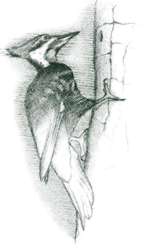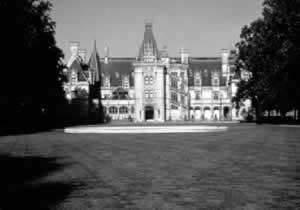 Craggy
Gardens Recreation Area
Craggy
Gardens Recreation Area  Craggy
Gardens Recreation Area
Craggy
Gardens Recreation Area [Fig. 21(11)] When summertime hits Asheville, northbound traffic on the Blue Ridge Parkway picks up as residents head for the Craggy Gardens Recreation Area only 15 miles away. The climb is steep from the lowlands around Asheville, and soon the summer swelter turns to cool, shady, and sometimes chilly conditions.
But Craggy Gardens isn't just for summertime—it is a popular destination any time of year, with high peaks and scenic views, rugged terrain, and heath balds covered with Catawba rhododendron. By mid- to late June, the mountainside is awash in pink and purple blossoms, perhaps the most spectacular display for miles around. In the fall, in addition to the carnival of color from deciduous trees turning gold, red, and orange, bouquets of bright red berries hang from the mountain-ash (Sorbus americana). Even in winter, the ice-encased branches of the gnarled hardwood forest of American beech (Fagus grandifolia), yellow birch (Betula alleghaniensis), buckeye (Aesculus octandra), and mountain-ash sparkle in bright sunlight.
The Craggies are widely regarded as one of the Parkway's most important botanical areas because they host a number of endangered and threatened plants. In addition to the rhododendron, the heath balds host mountain laurel, flame azalea (Rhododendron calendulaceum), and plentiful blueberry bushes (Vaccinium). Balds here are comprised primarily of grasses and wildflowers, which in some areas interweave through the heaths to form "pathways" through the rhododendron. Together the grasses and wildflowers form pieces in the puzzle of the southern Appalachian balds. Though many theories circulate about the origins of balds, the one that proposes some balds were man-made may apply here. In the Craggies, the balds were used cleared and used by early settlers for pasturing livestock during the summer months. Yet, most grazing ceased by 1920 and definitely stopped in 1950 when the National Park Service acquired the land, and the balds still exist. No one knows why.
The 700-acre site, recognized by the state as a Natural Heritage Area, includes a visitor center, picnic grounds, and several short but rewarding hiking trails. The Craggy Gardens Trail starts at the south end of the visitor center parking area or from the north end of the picnic area. From the south end of the visitor center parking area, the trail begins as a self-guiding nature trail with a moderate uphill climb to a large trail shelter, built by the CCC in 1935. The nature trail ends at the shelter, and a short spur trail crosses the rhododendron bald to spectacular views of the Black Mountain range. The main trail continues on a gradual descent into a mixed-hardwood forest to the picnic area. In this general area, violets, blackberry (Rubus argutus), mayapple (Podophyllum peltatum), and wild crabapple (Malus angustifolia) are just some of the colorful wildflowers that compete with the rhododendron for attention.
Craggy Pinnacle Trail delivers the most view for the least amount of walking. Only a moderate 20-minute walk is required from the upper level of the Craggy Dome Parking Overlook. From beginning to end, the trail is resplendent with tunnels of rhododendron, wildflowers, and more blueberries. The Lower Overlook, which is signposted after the last ascent, offers a different—and to some, more interesting—view of the geology and vegetation of the pinnacle. A reminder: as with all trails, though they appear lush and thriving, these are fragile environments. Stay on the designated trails and off the rocky outcrops. Even hard-to-see lichens and mosses play critical roles in our environment.
Longer trails include a segment of the Mountains-to-Sea Trail; the Snowball Mountain Trail (8 miles round-trip), accessed a short distance off the MST crossing at the picnic area; and the Carter Creek Falls Trail (8 miles round-trip—also known as Douglas Falls Trail). Access for this trail is from the picnic area. Follow the MST north for 1.5 miles to its intersection with Carter Creek Falls Trail. The trail is strenuous but leads through a series of cascades and two virgin hemlock groves on its way to the 70-foot falls. Improved access to the Mountains-to-Sea Trail has recently been completed at the south end of the visitor center parking area where the trail branches off to the right after 100 yards.
The Parkway provides easy access to many excellent bird-watching sites, and Craggy Gardens holds an esteemed reputation for birds. This is due in part to the work of John S. Cairns who late in the nineteenth century conducted field studies nearby. The parking area of the visitor center is a great place for easy birding, even for those confined to wheelchairs. The common raven (Corvus corax), veery (Hylocichla fuscenscens), winter wren (Troglodytes troglodytes), cedar waxwing (Bombycilla cedrorum), Canada warbler (Wilsonia canadensis), rose-breasted grosbeak (Pheucticus ludovicianus), and catbird (Dumetella carolinensis) are just some of the birds typically found here in late spring and summer.
 Biltmore
Estate and Gardens
Biltmore
Estate and Gardens [Fig. 21(24)] A winding 3-mile route through woodland groves provides an idyllic approach to the Biltmore Estate. Double rows of tulip trees flank the wide front lawn of this French Renaissance chateau that George Vanderbilt first opened to his guests in 1895.
The 250-room mansion, designed by Richard Morris Hunt, is the largest private residence in the United States. Many of the original furnishings, art, and antiques are on display in this National Historic Landmark. Eight thousand acres of the original 125,000-acre estate remain, including 75 acres of landscaped gardens, forested walking trails, rolling wooded parks, formal pleasure gardens, and riverside fields designed by landscape architect Frederick Law Olmsted as his last and largest project.
The 4-acre English Walled Garden is brilliant with more than 50,000 tulips, 40 varieties of annuals, perennial borders, and 2,000 roses in more than 100 varieties. The 15-acre Azalea Garden contains one of the most complete collections of native and hybrid azaleas in existence. More than 1,000 azaleas represent 14 native species in this spectacular display. The vibrant colors are dazzling beneath a canopy of century-old pines.
The sixteenth-century Italian Garden adds elegance with its reflecting pools and statuary, and the Conservatory offers a fragrant display of color with blooming tropicals and hothouse plants.
The Shrub Garden contains hundreds of native and exotic woody plants. A forest trail shows the care taken by the young forester, Gifford Pinchot, employed by the estate in one of the first organized attempts at forestry in the United States (see Cradle of Forestry).
The Bass Pond and Lagoon created from an old creek-fed millpond add another dimension of tranquil beauty to this magnificent estate. The Meadow Trail provides a high vista overlooking the pond where Canada geese (Branta canadenis), mallards (Anas platyrhnchos), and other waterfowl play. A waterfall drops in silvered beads to the creek below, and migrant songbirds, insects, and wildlife abound. Great blue herons (Ardea herodias), raccoons (Pipilo erythrophthalmus), gray and red foxes (Urocyon cinereoargenteus and Vulpes fulva), and beavers (Castor canadensis) have been spotted. The Estate Winery produces 75,000 cases of wine each year, using more than 200 tons of estate-grown grapes as part of the Biltmore philosophy of maintaining a self-sufficient, working estate.
[Fig. 21(18)] This is a garden with heart. Since its inception in 1960, nature-loving volunteers have planted, transplanted, and cultivated an extraordinary sanctuary for native flora and a vital wildlife refuge near the center of busy downtown Asheville.
Across the 10 acres of varied terrain—from creekside bog, to forested hillside, to wildflower-filled glade—the gardens are a living tribute to the rich biodiversity of the Southern Highlands. From the rare and endangered shortia or oconee bells (Shortia galactifolia) to the common and nutritious stinging nettle (Urtica dioica), more than 700 plant species thrive in the botanical gardens.
On a typical spring afternoon an artist sets up an easel, a photographer poses a young couple before a field of creeping buttercup (Ranunculus repens), and a lone visitor engages in contemplation sitting beneath a giant sycamore (Platanus occidentalis). Flushed joggers speed past young families strolling along paths graced with little sweet betsy (Trillium cuneatum) and wake robin (Trillium erectum). The fragrance of lily of the valley (Convallaria majalis) sweetens the air and joyful birdsong harmonizes with the soothing sound of Reed Creek flowing over the rocks, its rippled water gilded by the afternoon sun.
An original log cabin, rebuilt on site, provides a glimpse of earlier mountain habitation, and memorial plaques beneath flowering trees honor some of those who loved these gardens and helped preserve them.
Golden club (Orontium aquaticum) thrives in the bog-side lily pond. Carolina hemlocks (Tsuga carolinanian) reach skyward and flame azaleas brighten the wooded slopes. Two-winged silverbells (Halesia diptera), delicately blooming in spring, buzz with honey bees. Eastern chipmunks (Tamias striatus) and gray squirrels (Scirus carolinensis) scamper beneath flowering dogwoods (Cornus florida) in a meadow bordered with violets (Viola papilionacea). Pinxter flower azaleas (Rhododendron nudiflorum) and red buckeyes (Aesculus pavia) add to the beauty. Even the common burdock (Arctium minus), pokeweed (Phytolacca americana), and poor man's pepper (Lepidum virginicum) have a place here.
 Western
North Carolina Nature Center
Western
North Carolina Nature Center [Fig. 21(19)] Many natural events, both obvious and subtle, occur daily in the southern Appalachian Mountains. Their stories need telling and retelling for it is only through public education and subsequent public support that the environmental integrity of North Carolina's wild areas can be assured. Realizing this need, Buncombe County Recreation Services has provided the public with a first-class nature interpretation facility, the Western North Carolina Nature Center. The 42-acre facility evolved in the mid-1970s from the former Asheville City Zoo, which was in major need of renovation. Concerned citizens had been lobbying for remodeling of the zoo facility in keeping with "environmentally friendly" zoo modernization efforts under way around the nation. The Junior League of Asheville made the renovation project its priority in preparation for the July 4, 1976, bicentennial celebration. Today, as many as 90,000 visitors are received at the center each year.
A reception building that houses an information/ticket desk, gift shop, and restrooms opens the way to an array of choices. Inside the Main Exhibit Building, for example, live exhibits of reptiles, amphibians, and fish are complemented by hands-on areas where visitors can observe natural objects through microscopes, explore guessing boxes, or view the inner mechanisms of tree growth.
Back outside, paths lead to a turtle pond, various gardens, and the .6-mile Trillium Glen Nature Trail loop, which contains native southern Appalachian plants in a natural forest setting.
The biggest attraction of the nature center is its assemblage of native mammals and birds of prey. River otters (Lutra canadensis) bask on rocks or playfully swim in the water, and a special window enhances the viewing of the underwater antics of these graceful creatures. Visitors are also treated to habitats of the red fox, raccoon, white-tailed deer (Odocoileus virginia), black bear (Ursus americanus), cougar, bobcat (Lynx rufus), gray wolf (Canis lupus), and the endangered red wolf (Canis rufus). Feathered members of the menagerie include the peacock, wild turkey (Meleagris gallopavo), red-tailed hawk, great horned owl (Bubo virginianus), and golden eagle.
In other areas, the World Underground exhibit allows visitors to walk through dark subterranean wildlife habitats and experience what it is like to live within the hidden layers of soil and tree roots below the forest floor. The Educational Farm includes a barn that houses sheep, goats, and rabbits. A nearby corral area is open to kids and adults who want to approach and pet these creatures.
The nature center offers a series of creative programs throughout the year called Wild Weekends. Visitors who bring in an insect on Bug Day or a snake during the Snake Beauty Pageant earn free admission. (Insects are identified by a volunteer specialist, and snakes get a shot at winning the beauty pageant.) Other Wild Weekends include Farm Fun Day, Hey Day, and An Evening with the Reindeer. At the start of February, visitors are treated to a presentation on groundhog natural history and a chance to pet the center's resident groundhog (Marmota monax). Other programs offered by the nature center include indoor nature presentations and off-property day hikes.